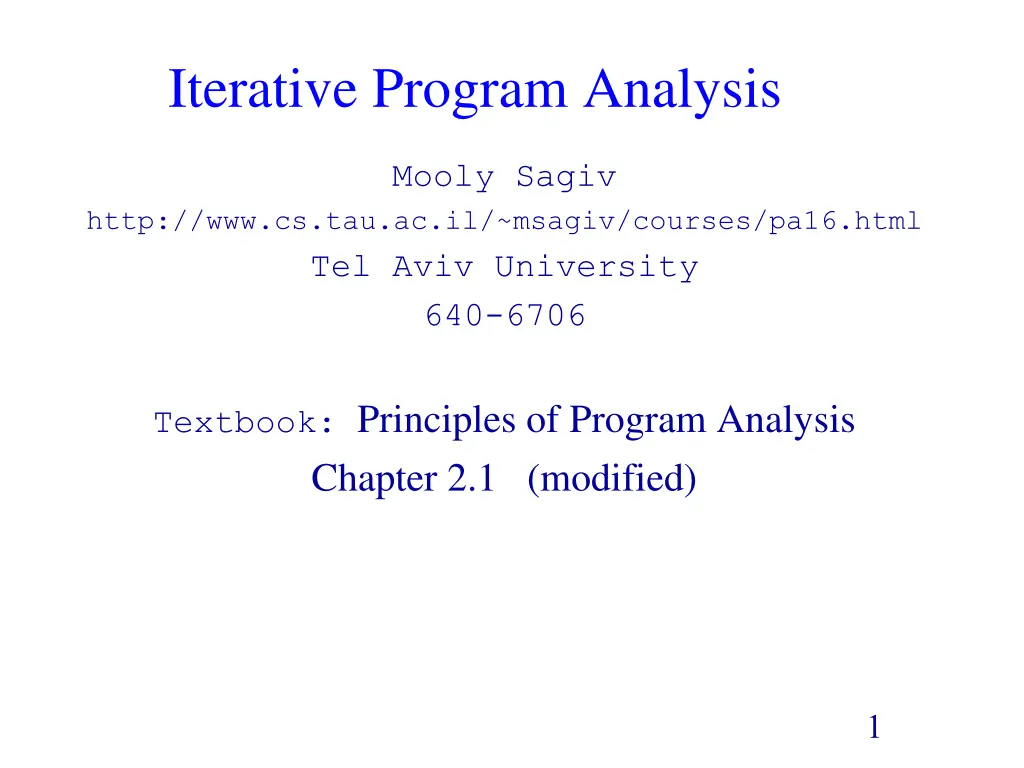
Understanding Iterative Program Analysis and Chaotic Iterations
Explore the concepts of iterative program analysis, chaotic iterations, and system of equations. Learn how to compute constants, define control flow graphs, and solve unique solutions through chaotic iterations in program analysis. Dive into examples and efficiency issues. Understand the impact of order of evaluation on the number of iterations in program analysis.
Download Presentation

Please find below an Image/Link to download the presentation.
The content on the website is provided AS IS for your information and personal use only. It may not be sold, licensed, or shared on other websites without obtaining consent from the author. If you encounter any issues during the download, it is possible that the publisher has removed the file from their server.
You are allowed to download the files provided on this website for personal or commercial use, subject to the condition that they are used lawfully. All files are the property of their respective owners.
The content on the website is provided AS IS for your information and personal use only. It may not be sold, licensed, or shared on other websites without obtaining consent from the author.
E N D
Presentation Transcript
Iterative Program Analysis Mooly Sagiv http://www.cs.tau.ac.il/~msagiv/courses/pa16.html Tel Aviv University 640-6706 Textbook: Principles of Program Analysis Chapter 2.1 (modified) 1
Subjects From programs to equations Examples of chaotic iterations Why can t we stop early? Why can t we start from top? Incompleteness Efficiency issues
Computing Constants Construct a control flow graph (CFG) Associate transfer functions with control flow graph edges Define a system of equations Compute the simultaneous least fixed point via Chaotic iterations The solution is unique But order of evaluation may affect the number of iterations
A Simple Example 1 [z := 3]1 z := 3 [x := 1]2 2 while ([x > 0]3) ( x := 1 x 0 if [x = 1]4then [y := 7]5 8 3 x > 0 else [y := z + 4]6 x 1 x = 1 4 [x := 3]7 x :=3 5 6 ) y := 7 y := z+4 7
A Simple Example: System of Equations DF[1] =[x 0, z 0] DF[2] =DF[1] z 3# DF[3] =DF[2] x 1# 1 z := 3 2 DF[4] =DF[3] x>0#DF[7] y:=7# x := 1 DF[5] =DF[4] x 1# DF[6] =DF[4] x=1# x 0 8 3 x :=3 x > 0 DF[7] =DF[5] y:=7#DF[7] y:=z+4# x 1 x = 1 4 DF[8] =DF[3] x 1# 5 6 y := 7 y := z+4 7
A Simple Example: Chaotic Iterations N DF[N] WL {1} {2} {3} {4, 8} {5, 6, 8} {6, 7, 8} {7, 8} {3, 8} {4, 8} {5, 6, 8} {6, 7, 8} {7, 8} {4, 8} {8} {} [x 0, y 0, z 0] [x 0, y 0, z 3] [x 1, y 0, z 3] [x 1, y 0, z 3] [x 1, y 0, z 3] 1 2 3 4 5 6 7 3 4 5 6 7 4 8 1 z := 3 2 x := 1 x 0 x :=3 8 3 [x 1, y 7, z 3] [x , y [x , y [x 1, y [x , y [x , y 7, z 3] x > 0 , z 3] , z 3] , z 3] , z 3] x 1 x = 1 4 5 6 y := 7 y := z+4 7 [x , y , z 3]
A Simple Example: System of Equations DF[1] =[x 0, z 0] DF[2] =DF[1] z 3# DF[3] =DF[2] x 1# 1 z := 3 2 DF[4] =DF[3] x>0#DF[7] y:=7# x := 1 DF[5] =DF[4] x 1# DF[6] =DF[4] x=1# x 0 8 3 x :=3 x > 0 DF[7] =DF[5] y:=7#DF[7] y:=z+4# x 1 x = 1 4 DF[8] =DF[3] x 1# 5 6 What happens when values are initialized to ? y := 7 y := z+4 7
A Simple Example: System of Equations DF[1] =[x DF[2] =DF[1] z 3# DF[3] =DF[2] x 1# , z ] 1 z := 3 2 DF[4] =DF[3] x>0#DF[7] y:=7# x := 1 DF[5] =DF[4] x 1# DF[6] =DF[4] x=1# x 0 8 3 x :=3 x > 0 DF[7] =DF[5] y:=7#DF[7] y:=z+4# x 1 x = 1 4 DF[8] =DF[3] x 1# 5 6 y := 7 y := z+4 7
When do we loose precision Dynamic vs. Static values Correlated branches Locality of transformers (Join over all path) Initial value
Low Level View Explicitly represent the program counter Create an abstract transition system which represents the analysis Execute transitions in arbitrary order
Low Level View (Example) State : PC (Var Val) 1: z = 3 Transformer: State State 2: x = 1 S. pc. v: while 3: (x > 0) ( 4: if (x = 1) then 5: y = 7 0 pc = 1 S 1 [z 3] v (S 2 [x 1] S 8) v S 3 v (S 4 [x 1, y , z S 4 v (S 5 [y 7] (S 6 [y (S 6 z) + 4] pc =7 pc =2 pc =3 pc =4 pc =5 pc =6 else 6: y =z + 4 7: x = 3 8: print y ]) v ) S 7 [x 3] v pc =8
Summary Chaotic iterations is a powerful technique Easy to implement Rather precise But expensive More efficient methods exist for structured programs
